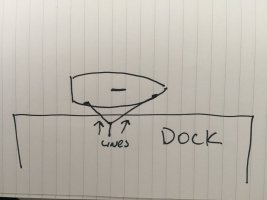lonokai
Member III
I sent this to a friend last week, when this occurred. Please bear in mind that I am a newbie and this is my first boat.

FEB 17, 2016
Early this morning, I hopped on the boat and started up the engine for a trip to your friendly pump out station. This time, I planned ahead as to what I was going to do. The head was totally full and I was with limited time today, so I just wanted to get over to the PO Station, dock, pump and return to the slip. I could not start any deep cleaning treatment.
I made a wide turn and slowly drifted up to the PO station. As soon as the boat was within 12" of the dock I hopped off and grabbed the aft line and tied it down..... Wrong, Eric, wrong. The bow drifted into the channel. So, I released the line, hopped onto the boat, started up the engine and made another wide turn back to the dock. Thank goodness there were no other boaters around to mock me!
This time, I took the bow line and tied it off first. Then grabbed the aft line and tied it down. I was proud of myself. I unscrewed the waste cap and went over and grabbed the hose....Alas. 2-feet short!
So, I put it down, released both lines and maneuvered the boat to position, tied it down and repeated the effort to pump out.
I know, I know, I know....now I know...YOU MUST MAKE ABSOLUTELY SURE YOU HAVE A GOOD SEAL/CONNECTION!. I Know! Because I was splattered with.....well, YOU KNOW.
When finished, I cleaned the hose, released the lines and took her into the slip.
Now I am ready to really clean the head.
And I know how to make a good seal so I don't get splattered again.
BTW, how do I know when the holding tank is totally empty? Is there a sound....the plastic see through on the pump is so crackled its hard to see...

FEB 17, 2016
Early this morning, I hopped on the boat and started up the engine for a trip to your friendly pump out station. This time, I planned ahead as to what I was going to do. The head was totally full and I was with limited time today, so I just wanted to get over to the PO Station, dock, pump and return to the slip. I could not start any deep cleaning treatment.
I made a wide turn and slowly drifted up to the PO station. As soon as the boat was within 12" of the dock I hopped off and grabbed the aft line and tied it down..... Wrong, Eric, wrong. The bow drifted into the channel. So, I released the line, hopped onto the boat, started up the engine and made another wide turn back to the dock. Thank goodness there were no other boaters around to mock me!
This time, I took the bow line and tied it off first. Then grabbed the aft line and tied it down. I was proud of myself. I unscrewed the waste cap and went over and grabbed the hose....Alas. 2-feet short!
So, I put it down, released both lines and maneuvered the boat to position, tied it down and repeated the effort to pump out.
I know, I know, I know....now I know...YOU MUST MAKE ABSOLUTELY SURE YOU HAVE A GOOD SEAL/CONNECTION!. I Know! Because I was splattered with.....well, YOU KNOW.
When finished, I cleaned the hose, released the lines and took her into the slip.
Now I am ready to really clean the head.
And I know how to make a good seal so I don't get splattered again.
BTW, how do I know when the holding tank is totally empty? Is there a sound....the plastic see through on the pump is so crackled its hard to see...

